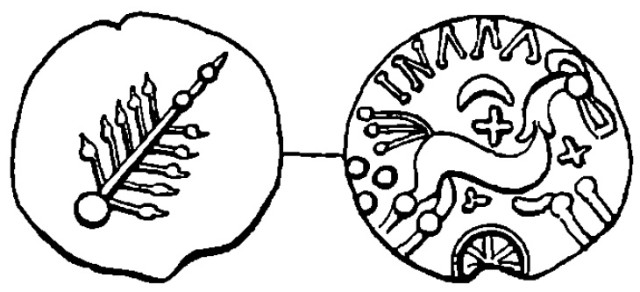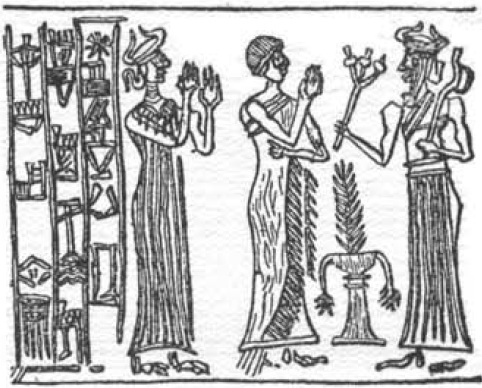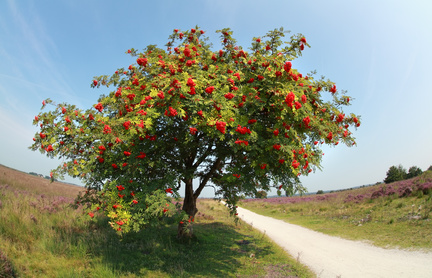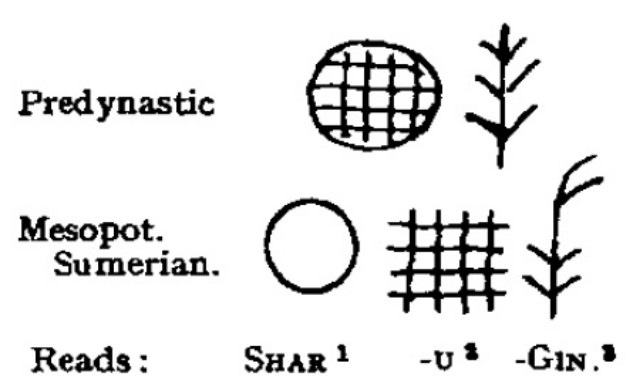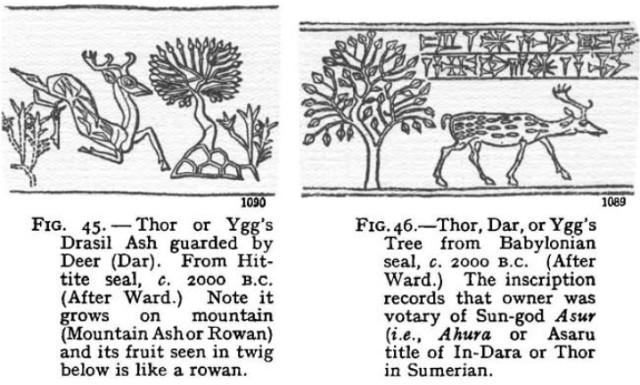
| VAJRA ON CATTI COINS AND TREE OF LIFE 11. Vajra on Catti Coins and Tree of Life :
1. Vajra on Catti Coins :
According to Lieutenant Colonel Laurence Austine Waddell :
The Phoenician Origin of Britons, Scots, & Anglo-Saxons (1924 - 1st. edition) :
On analysing this early Aryan Civilization thus suddenly introduced into India, in regard to its culture, social structure, customs, folklore and religion, and the traditional topography and climate of its ancestral homeland as described in the Vedas-descriptions wholly inapplicable to India I was led by numerous clues to trace these "Aryan" or as they called themselves "Arya" invaders of India back to Asia Minor and Syria-Phoenicia, I then observed that the old ruling race of Asia Minor and Syria-Phoenicia, from immemorial time, were the great imperial, highly civilized, ancient people generally known as "Hitt-ites," but who called themselves "Khatti" or "Catti," which is the self-same title by which the early Briton kings of the pre-Roman period called themselves and their race, and stamped it upon their Briton coins-the so-called "Catti" coins of early Britain. And the early ruling race of Aryans who first civilized India also called themselves "Khattiyo," as we shall see presently.
This ancient Khatti or "Catti" ruling race of Asia Minor and Syrio-Phoenicia also called themselves "Arri" with the meaning of "Noble Ones." Now this was the identical racial title which was also applied to themselves by the Indo-Aryans or Eastern branch of the Aryans, who called themselves "Arya," the "Ariya" of the older Pali, which had also the literal meaning of "Noble," and which is the actual word from which our modem English term "Aryan" has been coined. And these ancient Khatti or "Hittites" are represented in their ancient sculptures in Gothic dress. Here then already I seemed to have found not only the origin of the Indo-Aryans, but also the original land of the Aryan Race, and the homeland of the Goths and of our own ancestral Britons and Anglo-Saxons. And further examination soon confirmed this.
The civilization of this Arri (or Aryan) race of Khatti or "Catti" was essentially of the kind which is now called the Aryan type, and of the same type as that introduced into India by the Eastern branch of the Aryas or Aryans.
In appearance also these Khatti, who were called "The White Syrians" by Strabo, are seen in their own rock-sculptures and sculptured monuments of between 3000 and and 2000 BC., to be of the Aryan type. They are tall in stature, with conical "Phrygian" caps and snow boots with turned-up toes, and garbed significantly in what is now commonly called the "Gothic" style of dress, for the reason, as we shall see later, that they were the primitive Goths, and the Goths were typically Aryan in race.
FIG. 3 : "Catti" Briton Coins of pre-Roman Britain of about second century B.C. with Sun symbols. (After Poste) Note : The Crosses around Sun-horse, and in second coin contraction of title into "ATT". The "El" between the face and back of coin = Electrum alloy of gold of which coin consists, and A = Aurum or Gold.
FIG. 74. : Ancient Briton "Catti" coin of 2nd cent. B.C. with Sun-Crosses, Sun-horse, etc., and legend INARA (Hitto-Phoenician Father-god Indara or "Andrew") Here, in these coins we can see the Vajra as described in Purans.
Origins of Vajra ? :
Till now we have understood Vajra but now we will try to understand its origins. The origins of Vajra is in Sumerian civilization. Vajra is nothing but "The Rowan Wood".
The cross i.e. + was made from Rowan wood which is The Sacred Wood. The Cross i.e. +, Swastik and Spiral also represent Sun as Aryans are Sun worshippers.
According to According to Lieutenant Colonel Laurence Austine Waddell in his book The British Edda (1930) - Part 2 :
The Rowan as the True" Golden Bough" The Rowan Apple symbolism of the Red Cross-that cross being made as we have seen of Rowan-tree woodis especially prominent in these Eddic lays, although hitherto wholly unnoticed; and significantly the Rowan Apple is seen figured in several of the seals. The Cross is herein variously called "The Sacred Wood," "The Red Rud or Rood," "The Rowan Wood (Runn or Reym)," "The Rowan Stick-Goad or Spear," and "The Appled Ash of the Blazing Wood." This does not imply that the actual Rowan-tree branch with its golden scarlet-cheeked apple fruit-the true "Golden Bough," and devil-banishing talisman of Odysseus, and not the mistletoe as has hitherto been conjectured by all modern writers was itself always carried as a substitute for the Cross.
The
opening verse makes it quite clear that the Red Cross carried on
this occasion by Adam-George was a wooden standard called "the
pcdestalled rood" of carpentered Rowan wood in the form of
a Cross, and its wood wasprobably derived from Adam-George's own
great Ygg's Drasill-tree or Mountain Ash, i.e., Rowan (see Figs.
45, etc.), though in several of the seals it is figured as a Rowan-tree
branch. This Cross is now seen to be the remote historical original
not only of St George's Cross and the True Cross found in Christianity,
but also of the Fiery Cross carried by the Scottish clans in their
holy wars. It at the same time discloses the Adamite Gothic origin
of the old Scottish adage on the devil banishing effects of the
Rowan-tree :
FIG. 92 : King Thor or Sig carrying Rowan-branch as talisman, entering Eden (or Hell) for rescue of Ifo or Eve. From Sumer seal, c. 2400 B.C. (After Ward, 436) Note : King, called in inscription. "Lord Sag or Zag of the Sprout of the emerging Sun,"carrying the branch in right hand and club (here probably, a ploughshare) over left shoulder, is being addressed by El, while Eve with horned Gothic hat, holds up both hands in welcome.
The Rowan Tree The Symbol of Rowan Tree was also used by Sargon who was son of Indra / Adam / Thor and Eve / Inanna.
Below images are from Book of Lieutenant Colonel Laurence Austine Waddell "The Makers of Civilization in Race and History" :
FIG. 30. : Sealing of King GIN or "Sargon" at Abydos. (Photo after Petrie)
FIG. 31. : King Gin's or "Sargon's" Sealing from Abydos decipbered. Here it is seen that King Gin calls himself Sharu-Gin, suggesting that this seal was for use in Mesopotamia
Seal of Aha as Overthrower of King Mush :
Transl.
: AHA, The Overthrower of King MUSH
FIG.
92 : Seal of AHA as Overthrower of King MUSH deciphered
Here, we can clearly see from the Seal that the Vajra Symbol has value SIG which clearly means Sargon.
2. Tree of Life :
The Sumerian Tree of Life is described in Purans as Parijat. Though Parijat is a different tree but here, the Purans have got the wrong tree name or maybe Parijat meant Rowan-apple "Tree of Life," Ygg-Drasill which was later misunderstood.
As we know that Mountain Ash, Rowan-Ash, Rowan-apple "Tree of Life", Ygg-Drasill, Swastik and Cross represents Sun let us now go through its overview :
According to Lieutenant Colonel Laurence Austine Waddell :
The British Edda Part 1 :
The next scenes disclose Thor's conquest of Cappadocia (east of Phrygia) up to the Euphrates and down through the Taurus to the seaboard of Cilicia; his establishing his new chief capital at Vidara or Pteria (at Boghaz Koi), in the heart of Cappadocia, as "George of the Red Cross," the historical original of "St George of Cappadocia and England"; his building and fortifying his capital there, which he calls Himin or "Heaven"; his judgment-hall, his Rowan-apple "Tree of Life," Ygg-Drasill, as a symbol of the Sun; his establishing of Baptism as the initiating rite into his Sun-cult. There, having concluded a treaty with the Edenites, whose central Mother Weird's Serpent shrine and garden on the Euphrates was now only a few days journey to the south of his borders, he is visited in his mountain capital by a party of weird vestals from Eden, including Eve, to spy out his capital, and most of the episodes in these scenes also, from III onwards, are confirmed by the Sumerian and Hittite sculptures and seals, and Phrygian and Cappadocian monuments.
The courtship and marriage of Thor or Her-Thor (Ar-Thur) with Eve or Gunn-Ifa (Guin-Evere) the Eden vestal of the Serpent-cult, after her conversion by Thor to his Sun-cult, is dramatically described in the next scene; and significantly the Edda account is in full agreement down to the most minute detail with the great prehistoric bas-relief rock-sculptures of that ceremony near Pteria or Boghaz Koi, which the Edda now interprets for the first time, and also in agreement with the Sumerian, Greek and Indian records of that ceremony. Then follow scenes with Eve at home in Thor's mountain capital of "Heaven" as queen-consort of the Goths, and as custodian of the life-giving Rowan apples of the sacred tree; the birth and boyhood of Thor-Adam and Eve's son, the crown-prince Gunn or Kon (Cain or Gawain); the young prince Cain being treacherously wounded by the elderly Baldr or Epli (Abel), the son of Wodan and the Edenite Matriarch; Cain's succour by his mother Eve, who warns him against the treachery of the Edenites, and imparts to him on his initiation as a young solar Red Cross Knight the Ten Commandments of his father Adam-Thor.
The Phoenician Origin of Britons, Scots, & Anglo-Saxons (1924 - 1st. edition) :
The Sumerian writing on the Trojan amulets is in the archaic script which is found on the earliest sacred Sumerian seals and tablets of about 4000-3000 B.C. And it discovers unequivocally that these cup-marks with their associated True Crosses and Swastikas are prayers to the One God for resurrection from the dead, "like the Sun" in its supposed resurrection from the nether regions of Death and Darkness. This now explains why in Babylonia sacred seals, in series with these, were found attached to the wrists of skeletons in tombs, and why the seals from Cyprus, which frequently contain these circles, single and in groups, were found almost exclusively in Phoenician tombs of the Copper-Bronze Age : and why, in Britain, the cup-markings are mainly found on sepulchral dolmens and on stones in funereal barrows.
The True Cross, thus venerated as the emblem of Universal Victory of the One God symbolized in the Sun, was worn on the person, as we have seen, on a necklace, for adoration or as an amulet or charm. The manner of holding the portable handled or pierced form of Cross for adoration or abjuration is seen in Fig. 52 from a Hittite seal,s wherein additional rays of fiery light (or limbs of a St. Andrew's Cross) are added. As the Cross was made of wood, the ancient specimens have all now perished; but the frequent references in the Gothic Eddas to "The Wood" (which was made of the red Rowan Ash or "Quicken" Tree of Life), and its ash used for banishing devils and conquering enemies indicates its wide prevalence in Ancient Britain and Scandinavia.
And the modern popular superstition "to touch Wood" in
order to avert ill-luck is clearly a survival of this ancient "Sun-worship"
of the wooden Cross. The meaning of this superstition is now seen
to be, to touch the devil banishing Wood Cross of Victory of the
Sun-cult, which every Aryanized Briton carried on their person as
a luck-compelling talisman against the devils and Druidical curses
of the aboriginal Serpent-Dragon cult.
Below images are from Book of Lieutenant Colonel Laurence Austine Waddell "The British Edda (1930) part 2" :
|

